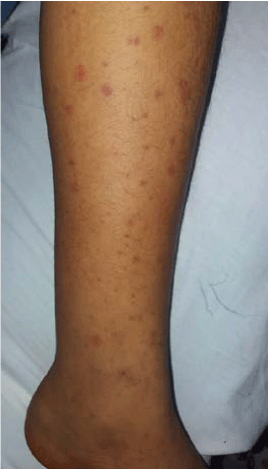Case Report
Henoch-Schonlein Purpura: Unusual Manifestation of Hepatitis A
Sellouti M¹*, El Kassimi I², Radi A¹, Ourrai A¹, Hassani A¹, Abilkassem R¹, and Agadr A¹
1Department of Pediatrics, Mohammed V Military Teaching Hospital, Morocco
2Department of internal medicine, Mohammed V Military Teaching Hospital, Morocco
*Corresponding author: Sellouti M, Department of Pediatrics, Mohammed
V Military Teaching Hospital, Rabat, Tel: 00212660627466; Email:
msellouti@gmail.com
Submitted: 10 March 2019; Accepted: 28 May 2019; Published: 30 May 2019
Cite this article: Sellouti M, El Kassimi I, Radi A, Ourrai A, Hassani A, et al. (2019)
Henoch-Schonlein Purpura: Unusual Manifestation of Hepatitis A. JSM Pediat Child Health 4: 2.
Henoch-Schonlein purpura is a systemic IgA vasculitis that affects small vessels. It is characterized by cutaneous purpura associated
with joint, abdominal and/or renal involvement. It is common in children and its etiology remains the result of immune complex reaction to
various antigens, its association with viral hepatitis A unusual.
We report the case of a 12-year-old girl who developed cholestatic jaundice secondary to viral hepatitis A. Two weeks after her
admission she presented with slender purpuric tasks of the lower limbs associated with arthralgia and abdominal pain. Histological study of
skin biopsy confirmed the diagnosis of Henoch-Schonlein purpura. The evolution was spontanously favorable.
This case highlights the fourtuitus association of Henoch-Schonlein purpura and hepatitis A.
Keywords:Henoch-Schonlein purpura; Cholestatic jaundice; Hepatitis A
Henoch-Schonlein purpura is the most common systemic
vasculitis of children that affects small vessels [1]. It is
characterized by a predominant purpura in sloping areas,
accompanied by arthralgia and/or arthritis of the large joints,
abdominal pain and renal involvement [2]. The cause is not well,
but is thought to result from a immune complex response to
various antigenic stimuli. The combination of HenochSchonlein
purpura and viral hepatitis A infection has been described
exceptionally in childhood [3,4]. The relationship between these
two conditions, however, remains unclear: accidental association,
“trigger” role or etiopathogenic factor.We report an observation
of Henoch-Schonlein purpura that occurred during an acute
infection with viral hepatitis A.
A 12-year-old girl, admitted for acute abdominal pain with
no particular medical history She reported vomiting, anorexia,
fatigue, dark urine, and jaundice. Clinical exam found normal
anthropometric measurements. The patient was afebril,with a
blood pressure at 115/56 mm Hg, and heart rate at 77 beats/
min. The abdominal examination was normal; the liver and the spleen were not palpable. The rest of the physical examination
was normal.
Biological assays showed hyperleukocytosis at 15203/mm3
(59% lymphocytes and neutrophils at 41%), hemoglobin at 9g
/dl, red blood cells at 4.1 106 / mm3, VGM at 70.2 μ3, 21.9μg
TCMH, 31.9% MCHC, and platelet count at 544 103/mm3. Hepatic
cytolysis with SGOT at 1299UI/l and SGPT at 880IU/l. Total
and direct bilirubin level respectively at 155 and 110μmol / l,
alkaline phosphatase at 290IU/ l, a prothrombin level at 42.9%;
kaolin cephalin time at 30 seconds (control at 25 seconds);
blood glucose level at 4.9mmol / l, a cholesterolemia at 4 mmol
/ l; hypertriglyceridemia at 3.45mmol / l, urea at 4.2 mmol and
creatininimia at 71μmol / l.
Hepatitis A serology was positive for IgM (IgM anti-HAV).
Serology of Hepatitis B (antigen HBS, antibody HBC), hepatitis C
(antibody HCV) and EBV (IgM VCA and IgG VCA) were negative.
The diagnosis of hepatitis A was retained. Two weeks later,
the patient expressed purpuric and infiltrated lesions of the
lower limbs (Figure 1) intensified by orthostatism associated
to arthralgia and abdominal pain. The urine test strip didn’t
find proteinuria nor hematuria. The cryoglobulinemia test was
negative. Skin biopsy showed a leukocytoclastic vasculitis.
After a follow-up of 6 months, the patient did not present other
episodes of HenochSchonlein purpura or any renal impairment.
In our case report, the diagnosis of Henoch-Schonlein purpura
is retained on the basis of clinical characteristic (purpura,
arthritis, and digestive manifestations) and histological findings
(leucocytoclastic vasculitis on the cutaneous biopsy). The
recent character of the viral hepatitis A infection is, for its part,
authenticated by the presence of IgM controlled twice. The first
case of Henoch-Schonlein purpura associated with viral hepatitis
A has been reported in the literature by Garty [3]. Four other cases
(three boys and one girl) have been reported since that date [4,5]. The mean age of these cases was 10.4 years and all had symptoms
of viral hepatitis A associated with cutaneous manifestations of
HenochSchonlein purpura. Extrahepatic manifestations during
viral hepatitis occur in 15 to 20% of patients and take variable
aspects. These events are reported much more frequently with
hepatitis B than with hepatitis A and C [6]. Their physiopathology
is not yet known but they would, for most authors, be the clinical
expression of an autoimmune disorder.
The combination of Henoch-Schonlein purpura with hepatitis
B or C is known despite its rarity [7,8]. However, the association of
Henoch-Schonlein purpura with hepatitis A remains exceptional
since only five cases are reported to date.
This case report highlights the unusual association of Henoch-
Schonlein purpura and viral hepatitis A. the diagnosis of Henoch-
Schonlein was retained on the basis of the American College of
Rheumatology (ACR) criteria: age < 20 years, palpable purpura,
acute abdominal pain, polynuclear infiltration of the vascular
wall and perivasculare at biopsy. These criteria do not include
immunofluorescence data. This one typically shows during the
Henoch-Schonlein a deposit of IgA in vessel walls. But, during
hepatitis A, there is usually a deposit of IgM [4,9]. IgA vascular deposits found in other cases of Henoch-Schonlein purpura
associated with hepatitis B or C are rare. Indeed, the deposits
in cases associated with hepatitis B, correspond to immune
complexes containing the HBS antigen, anti-HBs IGMs, IGGs,
complement fractions C3 and C4 [10,11].
In summary, we believe that hepatitis A infection may
be associated with Henoch-Schonlein purpura. Hepatitis A
essay should be established in every children with elevated
transaminase levels especially in developing countries where
hepatitis A is common.
 Figure 1:Purpuric and infiltrated lesions. View Figure
Figure 1:Purpuric and infiltrated lesions. View Figure






























